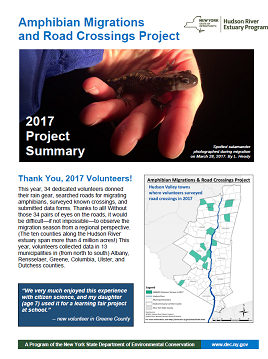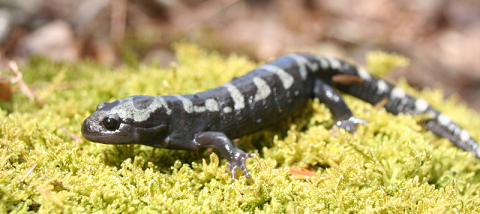Amphibian Migrations - 2017 Summary and Marbled Salamanders
The New York State Department of Environmental Conservation sent this bulletin on 09/06/2017 05:53 PM EDT |
| DEC Delivers - Information to keep you connected and informed from the NYS Department of Environmental Conservation |
| Share or view as a web page || Update preferences or unsubscribe |
AMPHIBIAN MIGRATIONS & ROAD CROSSINGS
|
||||

Hello! On this rainy September day, you may be waxing nostalgic for the amphibian migrations that occurred earlier this year. Read on to get caught up with your salamander and frog neighbors! First, there is a brief summary of the 2017 migration season posted on the Amphibian Migrations & Road Crossings (AM&RC) project website. The report includes observations on species of salamanders, frogs, and toads that were documented by volunteers, as well as weather conditions during migration. Second, we're entering into the breeding season of another vernal pool salamander -- the marbled salamander (Ambystoma opacum). New York is near the northern limit of the marbled salamander's range and the species is listed as Special Concern by the NYSDEC. Marbled salamander is in the mole salamander family, which also includes spotted salamander (A. maculatum) and Jefferson-blue spotted salamander complex (A. jeffersonianum x laterale). Like these species, marbled salamander lives in forest habitats, where it spends most of its life under ground, and breeds in vernal pools. Unlike these species, which breed in late winter, the marbled salamander breeds in late summer and autumn.
On rainy nights in September and October, marbled salamanders migrate to vernal pools for mating. Females deposit 50-200 eggs in dry vernal pools, and guard their eggs until rain fills the pool and triggers the eggs to hatch. If you see salamander larvae swimming under the ice in a vernal pool in winter and early spring, they are likely marbled salamanders!
We don't track marbled salamanders for the AM&RC project, but for your own interests, on rainy nights in the coming weeks, you may want to check local roads where you've seen spotted salamanders and wood frogs crossing during March and April migrations. It's possible they're using the same vernal pool and you'll have an opportunity to see the wonderfully plump little marbled salamander! Best,
The Amphibian Migrations & Road Crossings project is part of a larger effort to partner with local communities to conserve forests, wetlands, and natural areas that sustain the health and resiliency of the entire estuary watershed. For more information, see http://www.dec.ny.gov/lands/5094.html. Laura Heady |


